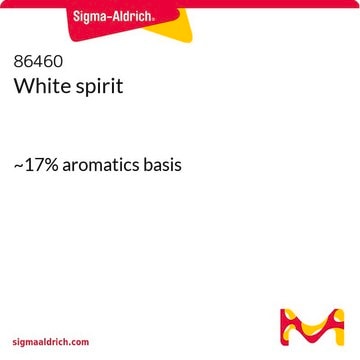334111
Dipentene
technical, for use as solvent (for the paint industry), mixture of various terpenes
Synonym(s):
(±)-Limonene, p-Mentha-1,8-diene
About This Item
Recommended Products
grade
for use as solvent (for the paint industry)
technical
vapor density
>4.7 (80 °C, vs air)
vapor pressure
1 mmHg ( 20 °C)
form
liquid
autoignition temp.
458 °F
composition
Major isomer: 3-Carene
Minor isomers: Limonene, β-pinene and α-pinene
expl. lim.
0.7-6.1 %, 150 °F
refractive index
n20/D 1.473 (lit.)
bp
170-180 °C (lit.)
density
0.86 g/mL at 20 °C (lit.)
SMILES string
CC(=C)C1CCC(C)=CC1
InChI
1S/C10H16/c1-8(2)10-6-4-9(3)5-7-10/h4,10H,1,5-7H2,2-3H3
InChI key
XMGQYMWWDOXHJM-UHFFFAOYSA-N
Looking for similar products? Visit Product Comparison Guide
General description
Application
Other Notes
Signal Word
Warning
Hazard Statements
Precautionary Statements
Hazard Classifications
Aquatic Acute 1 - Aquatic Chronic 1 - Flam. Liq. 3 - Skin Irrit. 2 - Skin Sens. 1
Storage Class Code
3 - Flammable liquids
WGK
WGK 2
Flash Point(F)
109.4 °F - closed cup
Flash Point(C)
43 °C - closed cup
Personal Protective Equipment
Certificates of Analysis (COA)
Search for Certificates of Analysis (COA) by entering the products Lot/Batch Number. Lot and Batch Numbers can be found on a product’s label following the words ‘Lot’ or ‘Batch’.
Already Own This Product?
Find documentation for the products that you have recently purchased in the Document Library.
Customers Also Viewed
Our team of scientists has experience in all areas of research including Life Science, Material Science, Chemical Synthesis, Chromatography, Analytical and many others.
Contact Technical Service

















